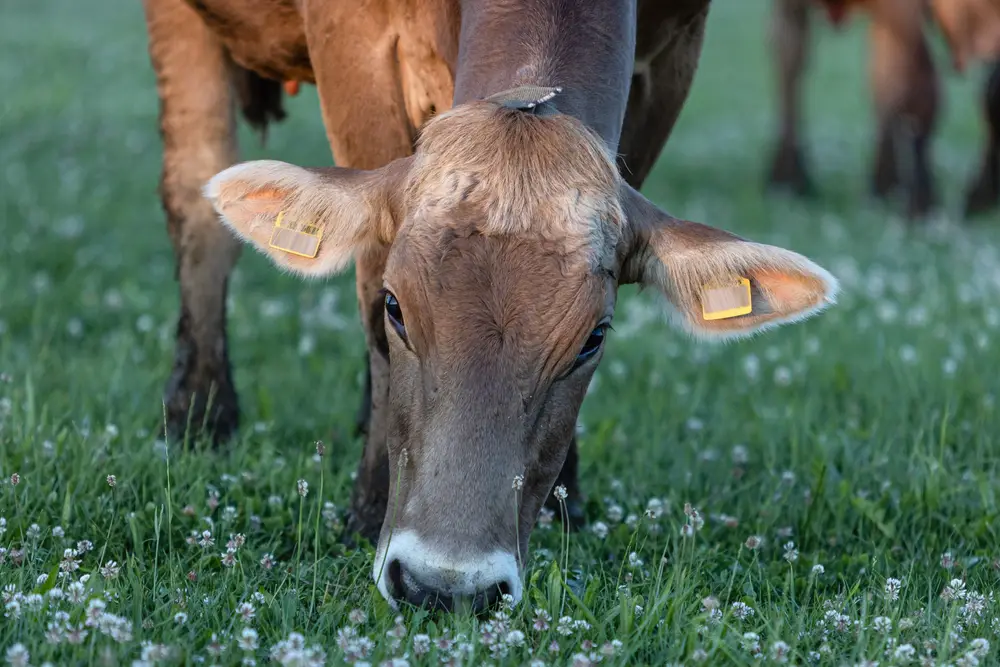Clover can kill cattle because it causes pasture or frothy bloat when consumed in excess. Frothy bloat is a result of a stable foam in the rumen that prevents cattle from expelling rumen gases. This is a serious condition that can be fatal if not treated quickly.
Clover causes foam production because it contains high levels of soluble protein. Cattle are likely to bloat during autumn and spring because of lush green pastures.
Table of Contents
Symptoms Of Excessive Consumption
Here are the symptoms of excessive consumption of clover:
- Swollen left abdomen
- Extension of the head
- Frequent kicking of the belly
- Frequent urination and defecation
- Repetitive standing and lying down
- Labored breathing and grunting
- Sudden collapse
Treatment Options
You can treat bloating in cattle with the two following techniques:
| Gassy bloat | Insert a stomach tube inside the cow’s throat to help it release the gas. The tube needs to be repositioned repeatedly to achieve the correct position. If done correctly, the cow will release the gas. |
| Frothy bloat | Administer anti-foaming agents through the tube. This will help break down the foamy substance. |
If the bloating continues, contact a veterinary officer.
How To Prevent Pasture Bloat
Bloat prevention is a vital part of cattle farming. Follow these tips to keep your cattle healthy:
- Pasture for cattle should contain more grass and fewer high-risk plants
- The legume-grass proportion growth rates should be monitored during their growing season
- Hungry cows should never be allowed to pasture in areas with a large amount of bloat-causing plants
- Fill the cows with dry hay or grass pasture before allowing them to feed on lush legume pasture
- Use Bloat Guard (Poloxalene) to reduce bloating incidences
Types Of Clovers And Their Effects On Cattle
Yellow Sweet Clover
Yellow Sweet clover is a biennial legume mainly planted to be used as hay and pasture. Its roots help to prevent soil erosion and fix nitrogen in the soil.
It is a valuable crop since it provides high-energy forage to lactating dairy cows.
Its disadvantage is that it is less digestible and contains the toxin coumarin.
Coumarin is converted to a toxic substance called dicoumarol when the yellow sweet clover is spoiled or heated. Dicoumarol suppresses vitamin K production which is responsible for the blood clotting process. This can result in tissue hemorrhage and severe blood loss in ruminants.
Symptoms of yellow sweet clover poisoning include:
- Stiffness
- Lameness
- Dull attitude
- Swelling beneath the skin, particularly at the hips, brisket, and neck
- Blood dripping from the nostrils
- Pale mucous membrane
When a pregnant cow consumes excess sweet clover the result is premature birth or miscarriage.
To reduce the chances of yellow sweet clover poisoning, the sweet clover should be dried enough before it is baled.
White Sweet Clover
White clover is a perennial legume that is essential for milk production in dairy cows. It has a 17- 33% protein content and it is mainly used for hay and silage-making process.
Excessive consumption of white clover can cause bloating.
Red Clover
Red clover is a biennial legume that is commonly grown as pasture for cattle. It is rich in protein and is harvested for hay and silage.
Red clover plays a role in fixing nitrogen in the soil through root nodules.
Predominant red clover in a pasture is known to moderately cause bloating in cattle. To avoid this, red clover is planted as part of a pasture with ryegrass.
Crimson Clover
Crimson clover is an annual legume that contains 12-14% crude protein and 60-65% digestible nutrients at full blossom.
Crimson clover is used for pasture or hay. It is much less likely to cause bloat in cattle.
Alsike Clover
Alsike clover is used for soil improvement, hay, and pasture. It is a nutritious feed for cattle and has the same nutritive value as white clover.
Alsike clover’s toxicity can lead to bloating in ruminants and photosensitization and big liver syndrome in horses.
Balansa Clover
Balansa clover is an annual legume used for silage, hay, or green manure. It is the most cold-tolerant clover able to withstand extreme temperatures.
Balansa clover does not cause pasture bloat to cattle.
Berseem Clover
Berseem clover is a fast-growing summer crop rich in calcium and 18-28% protein content.
Also known as Egyptian clover, berseem clover germinates quickly and can be mixed with ryegrass for cattle grazing.
There have been no reported cases of bloat caused by berseem clover.
Other Plants That Cause Pasture Bloat
Other plants that cause bloating can be categorized into high and low potential:
| High potential plantsAlfalfa and winter wheatLow potential plantsPerennial ryegrass, spring wheat, oat, and arrowleaf clover |
Alfalfa is one of the most nutritious forages for beef and dairy cattle. It is a rich source of protein hence it can also be fed to pregnant cows.
Alfalfa causes frothy bloat in cattle so it is advisable to mix it with a high fiber feed like grass hay.
Never feed starving cattle alfalfa as they will consume too much of it quickly, resulting in bloat.
How To Manage Feeding Of Clover To Cattle
While clover causes bloat to cattle, it still increases farm and cattle yields.

Clover is especially good for beef cattle as a highly nutritious feed that can increase their weight but should be introduced gradually.
Here are tips to guide you on the proper use of clover:
- Ensure that clover mixed with hay is dried thoroughly to discourage mold formation.
- Don’t feed clover to cows in the morning when clover is wet.
- Avoid feeding moldy sweet clover to cattle.
- Provide a sufficient supply of water and minerals to the cattle.
- Rotate the type of feed for cattle
Clover is not toxic unless it gets damaged by frost or is infected with fungus.
